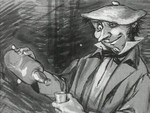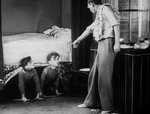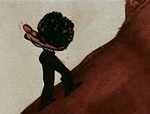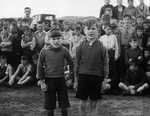Scots Language - Third and Fourth Levels
- Introduction
- Lesson
- Film Clips
- Print All
Introduction
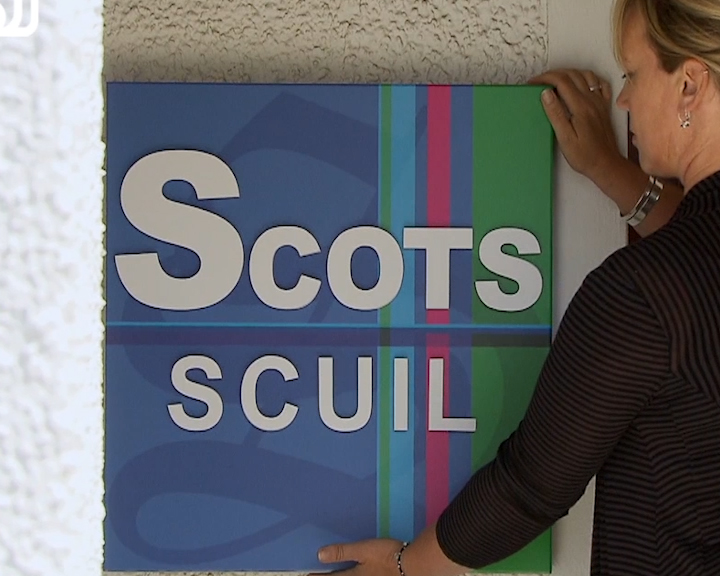
This lesson guide is about Scots language and uses clips from Scotland’s moving image archive and BBC Scotland.
You will learn about different approaches and uses of Scots language on film and television. You may be aware of some Scots words already. Scots is one of Scotland’s three indigenous languages (along with English and Gaelic) and has its own literature and history.
Watch the clips in this resource and think about the historical contrasts and social factors that have shaped where the language is today.
Note for teachers:
These films have been selected to accompany the learning journey 'Scots Language'(see file below). The downloadable learning journey connects with different areas of the Curriculum for Excellence (Third and Fourth Levels), with particular relevance to literacy, social studies, expressive arts, technologies and health and wellbeing. It is also a helpful learning aide for those studying for the Scots language and Scottish Studies Awards.
Attached Files
Lesson
Watch these films and answer the questions
FILM 1: Scots Scuil (2012)
This clip is an excerpt from “Scots Scuil”, an hour long programme where James Robertson and Matthew Fitt invited Scots speaking bairns to come and “speak their ain leid fir a week.”
This clip focuses on Cameron’s story and his decision to speak Scots.
Listen out for: “a wee bit of a stooshie...”
“A’ll jist set the box here the now...”
“if Ah git telt oaf bi ma Gran...”
What do you see? What is happening? Talk about any questions you have about the programme.
EXPLORE
This clip is an excellent example of a young person today who does speak Scots and wants to use it more but has some reservations.
What views are expressed by the different people in the various settings listed below? Where is it seen to be okay to speak Scots and where are the places thought better suited to speaking English?
• the home • work • an interview • with friends • with family • at school
From your list, do you agree that there is an 'appropriate' time and place for Scots? You might consider all to be acceptable settings for speaking in Scots language – give reasons.
DISCOVER
Because of factors relating to the history and development of Scots, the language is stigmatised and suffers from a very low status and lack of respect – particularly in Scotland itself.
Consider and research why we have Matthew, James and Cameron’s Papa – all quite passionately – advocating the use of Scots.
Research why Scots might not be considered 'slang' and can have a place in modern Scotland.
CREATE
Create a commentary of your own, like the news story documenting the “Scots Scuil”.
As a team (or in small groups) plan a documentary exploring the views and attitudes held firstly within your class, then also across your school and, if possible, across your community.
FILM 2: Tam Trauchle’s Troubles clip 1 (1934)
This clip shows the conditions in a 1930s Glasgow single-end tenement flat, including the recess bed, stove and eating area all in the one room. The Trauchle family is introduced with Tam Trauchle and his sons Sam and Robert at home. This is an early sound film and the quality of the sound is muffled.
Listen out for: “Ah ken hoo tae teach ye!”
“they dishes”
“We huvnae the money [...] let’s hae a sang”
EXPLORE
The film is introduced by Sir Charles Cleland in English but also features a variety of Scots language vocabulary and grammar used by the Trauchle family.
What is the effect of the English used by Sir Charles and the woman from the Education Authority when contrasted with the Scots used by Tam and the boys?
What has changed or stayed the same since the 1930s in terms of the place of Scots language in Scotland today?
To what extent do you consider speaking Scots to one person, then English to another, to be an example of being bilingual?
The regional variety of Scots language used in and around Glasgow is referred to by linguists as “West Central Scots”.What are the unique features of West Central Scots, used both in the film and in Glasgow today?
DISCOVER
What can you find out about Scottish families living in poverty today and in the past? Which charities have helped them?
Tam is a house husband. Was this common at the time and is it less or more common today?
Ask yourself what you do to help around your home? Research Scotland’s tradition of men going out to work and how the role of women has changed since the 1930s.
Scots language is most commonly, though not exclusively, used in the home – why is this?
Research the history and development of Scots language looking at significant events that have pushed Scots out of public life and into private life.
What are the exceptions to this in today’s society? Can you find example of Scots language in the media, in politics, on display in the town/city where you live?
CREATE
Prepare a digital presentation on your local area. Write and deliver the presentation including some Scots language.
Use technologies such as film clips and sound recordings where appropriate.
Create a film or webpage for your school about the culture and heritage of all the learners in your school. Use Scots and other languages as appropriate.
The scenes from Tam Trauchle’s Troubles are obviously staged. Write scenes set in a Scottish home using features of Scots language which you have learned.
FILM 3: Tam O’ Shanter (1958)
In this film the famous Robert Burns poem is recited and illustrated with drawings.
Listen out for: “drouthy neibors”
“...it gars me greet”
“Cutty-sarks rin in your mind”
Look out for: how the use of still images reinforces the impression of this as a literary text
EXPLORE
A narrative poem written by Burns in 1790, Tam O’Shanter uses a mix of English and Scots. Identify and translate the Scots language used in the text.
What other writers from Scottish literary history have explored the two languages in their texts?
Due to his drunkenness, Tam sees all manner of hallucinations. How does Burns use Scots to develop these in the poem?
Intoxication features in a great many Scottish texts,both poetry and short stories, novels and films. Discuss how this reflects and shapes Scottish identity, both past and present. What are your views on this portrayal of Scottish heritage and culture?
DISCOVER
Scots and English are sister languages, in the same way that there is often significant intelligibility between different Scandinavian languages, but they are classified as separate languages. Much of Scots is readily intelligible, with some practice, to an English speaker.
Research and discover the shared history of English and Scots from its Germanic roots, through to Old English and Anglian.
During a dark period for Scots language, in 1752 long lists of Scots words were drawn up to enable writers to avoid them! Although prejudice developed towards Scots language throughout the seventeenth and eighteenth centuries, Scots continued to be spoken by ordinary people across the country.
What examples can you find of Scots language now having a respected place in Scotland today,beyond its place in literature and in the home?
In the second half of the eighteenth century, there was a great flourishing of poetry in Scots. Robert Burns in Ayrshire most famously brought the Scots language to the world. At his peak, Sir Walter Scott was the most famous author in the world. Find out how Scots language literature and film has been treated by international audiences.
CREATE
In the 1990s, Scottish figurative painter Alexander Goudie created a cycle of 54 large format paintings dedicated to this Robert Burns’ poem. Look at the paintings and study Goudie’s illustrations in contrast to those used in the film clip.
Storyboard a script for the poem where instead of illustrations (as used in the film clip) your new version of the film is live action.
Can you retell the poem in contemporary Scots, using words and phrases from your local variety of Scots language?
FILM 4: Sisyphus (1971)
A version in Scots of the Greek legend of Sisyphus, read by Robert Garioch himself.
Listen out for:
“Bumpity doun in the corrie gaed whuddran the pitiless whun stane, Sisyphus dodderan eftir it, shair of his cheque at the month’s end.”
Look out for: the style of animation and colours used
EXPLORE
Watch the film then read the text for Robert Garioch’s Scots retelling of this Greek myth. To what extent does being based on a myth make this story of the everyday “wee” man of Scotland into something more meaningful?
How does the story being told in Scots language add to the meaning?
What words and phrases has Garioch successfully incorporated into his text which are unique to Scots language?
Scots language is often used for comic purposes. Identify and discuss the way Garioch and the makers of the film use Scots language to comic effect?
Contrast this with the deeper meanings of the text and how it reflects the identity of the working class Scot during different times in Scotland’s history.
How effective is this style of animation in reflecting Sisyphus’ struggle?
DISCOVER
There are different ‘regional varieties’ or dialects of Scots which taken altogether are collectively known as Scots language.Despite some differences due to the different social, linguistic, cultural and historical influences unique to each area, the regional varieties of Scots are mutually intelligible.
Which other modern languages are similar to this? For example, modern day Greek has a standard written form, but many different spoken dialects.
The name ‘East Central South’ is used to acknowledge the unique variations that appear in some of the Scots language used in and around Edinburgh.
What features can you find in the film, or from your own knowledge that are unique to Edinburgh?
Robert Garioch, a proud speaker of the Scots unique to Edinburgh, translated over a hundred satirical sonnets by the Italian poet Guiseppe Belli (1791–1863), which written originally in a dialect of Italian. Research Garioch’s sonnets and translations of Belli, starting with the poem The Philosopher Cafe-Proprietor and The Dug.
CREATE
Play only the sound from the film – no picture, just Garioch’s voice. Using the narration as your script, storyboard a new version for the films’ visuals.
Will your film adaptation of the text still be an animation? If so, how can you incorporate modern technologies and techniques to make your version unique and vibrant?
If not, where is your film set? Can you go location scouting in places accessible to you?
Can you also create a musical score? You can source existing music or sounds for your film or create new music.
WEBLINKS
Please see the Learning Journey pdf for relevant weblinks.
The Scots Language learning journey was prepared by Bruce Eunson (Education Scotland) in collaboration with the National Library of Scotland Moving Image Archive. Thanks to BBC Scotland. Created 2016.
